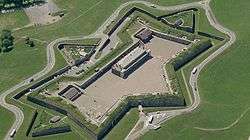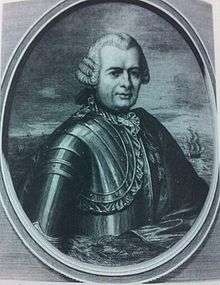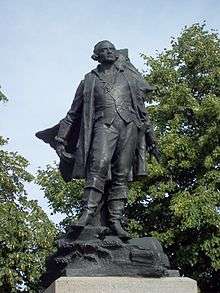Siege of Louisbourg (1758)
| ||||||||||||||||||||||||||||||
The Siege of Louisbourg was a pivotal operation of the Seven Years' War (known in the United States as the French and Indian War) in 1758 that ended the French colonial era in Atlantic Canada and led directly to the loss of Quebec in 1759 and the remainder of French North America the following year.[4]
Background
The British government realized that with the Fortress of Louisbourg under French control, there was no way that the Royal Navy could sail up the St. Lawrence River for an attack on Quebec unmolested. After an expedition against Louisbourg in 1757 led by Lord Loudon was turned back due to a strong French naval deployment, the British under the leadership of William Pitt resolved to try again with new commanders.
Pitt assigned the duty of capturing the fortress to Major General Jeffrey Amherst. Amherst's brigadiers were Charles Lawrence, James Wolfe and Edward Whitmore, and command of naval operations was assigned to Admiral Edward Boscawen. The chief engineer was John Henry Bastide who had been present at the first siege of Louisbourg in 1745 and was chief engineer at Fort St Philip, Minorca, in 1756 when the British had surrendered the fort and island to the French after a long siege.
As they had in 1757, the French planned to defend Louisbourg by a large naval build-up. However, the French fleet sailing from Toulon was blockaded in Cartagena by a British force, and a relief force was defeated at the Battle of Cartagena. After this the French abandoned their attempt to reinforce Louisbourg from the Mediterranean, meaning there would be few ships available to actively oppose the British off Louisbourg.
Order of battle

British forces assembled at Halifax, Nova Scotia where army and navy units spent most of May training together as the massive invasion fleet came together. After a large gathering at the Great Pontack, on 29 May the Royal Navy fleet departed from Halifax for Louisbourg. The fleet consisted of 150 transport ships and 40 men-of-war. Housed in these ships were almost 14,000 soldiers, almost all of whom were regulars (with the exception of four companies of American rangers). The force was divided into three divisions: Red, commanded by James Wolfe, Blue, commanded by Charles Lawrence and White commanded by Edward Whitmore. On 2 June the British force anchored in Gabarus Bay, 3 miles (4.8 km) from Louisbourg.
The French commander (and governor of Île-Royale (New France), the Chevalier de Drucour, had at his disposal some 3,500 regulars as well as approximately 3,500 marines and sailors from the French warships in the harbour. However, unlike the previous year, the French navy was unable to assemble in significant numbers, leaving the French squadron at Louisbourg outnumbered five to one by the British fleet. Drucour ordered trenches to be prepared and manned by some 2,000 French troops, along with other defences, such as an artillery battery, at Kennington Cove.
The Siege

Weather conditions in the first week of June made any landing impossible and the British were only able to mount a bombardment of the improvised shore defenses of Gabarus Bay from a frigate. However, conditions improved, and at daybreak on 8 June Amherst launched his assault using a flotilla of large boats, organized in 7 divisions, each commanded by one of his brigadiers. French defenses were initially successful and after heavy losses, Wolfe ordered a retreat. However, at the last minute, a boatload of light infantry in Wolfe's division (i.e., members of Rogers Rangers) found a rocky inlet protected from French fire and secured a beachhead. Wolfe redirected the rest of his division to follow. Outflanked, the French retreated rapidly back to their fortress.
Continuing heavy seas and the difficulty inherent to moving siege equipment over boggy terrain delayed the commencement of the formal siege. In the meantime, Wolfe was sent with 1,220 picked men around the harbour to seize Lighthouse Point, which dominated the harbour entrance. This he did on 12 June. After eleven days, on 19 June, the British artillery batteries were in position and the orders were given to open fire on the French. The British battery consisted of seventy cannons and mortars of all sizes. Within hours, the guns had destroyed walls and damaged several buildings.
On 21 July a mortar round from a British gun on Lighthouse Point struck a 74 gun French ship of the line, L'Entreprenant, and set it ablaze. A stiff breeze fanned the fire, and shortly after the L'Entreprenant caught fire, two other French ships had caught fire. L'Entreprenant exploded later in the day, depriving the French of the largest ship in the Louisbourg fleet.
The next major blow to French morale came on the evening of 23 July, at 10:00. A British "hot shot" set the King's Bastion on fire. The King's Bastion was the fortress headquarters and the largest building in North America in 1758. Its destruction eroded confidence and reduced morale in the French troops and their hopes to lift the British siege.
Most historians regard the British actions of 25 July as the "straw that broke the camel's back". Using a thick fog as cover, Admiral Boscawen sent a cutting-out party to destroy the French ships in the harbour. The British raiders eliminated the last two French ships of the line, capturing the Bienfaisant and burning the Prudent, thus clearing the way for the Royal Navy to enter the harbour. James Cook, who later became famous as an explorer, took part in this operation and recorded it in his ship's log book.[5]
Capitulation
| Part of a series on the | ||||||||||||||||||||||||||||||||||||||||||||||||||||||||||||||||||
| History of Nova Scotia | ||||||||||||||||||||||||||||||||||||||||||||||||||||||||||||||||||
|---|---|---|---|---|---|---|---|---|---|---|---|---|---|---|---|---|---|---|---|---|---|---|---|---|---|---|---|---|---|---|---|---|---|---|---|---|---|---|---|---|---|---|---|---|---|---|---|---|---|---|---|---|---|---|---|---|---|---|---|---|---|---|---|---|---|---|
.jpg) | ||||||||||||||||||||||||||||||||||||||||||||||||||||||||||||||||||
| Events | ||||||||||||||||||||||||||||||||||||||||||||||||||||||||||||||||||
|
||||||||||||||||||||||||||||||||||||||||||||||||||||||||||||||||||
| Other | ||||||||||||||||||||||||||||||||||||||||||||||||||||||||||||||||||
| ||||||||||||||||||||||||||||||||||||||||||||||||||||||||||||||||||
On 26 July the French surrendered. Having fought a spirited defence, the French expected to be accorded the honours of war, as they had given to the surrendering British at the Battle of Minorca. However, Amherst refused, tales of the atrocities supposedly committed by France's native allies at the surrender of Fort Oswego and Fort William Henry probably fresh in his mind. The defenders of Louisbourg were ordered to surrender all of their arms, equipment and flags. These actions outraged Drucour, but because the safety of the non-combatant inhabitants of Louisbourg depended upon him he reluctantly accepted the terms of surrender. The Cambis regiment refused to honour the terms of surrender, breaking its muskets and burning its regimental flags rather than hand them over to the British victors.[6] Brigadier-General Whitmore was appointed the new Governor of Louisbourg, and remained there with four regiments.[7]
Aftermath
Louisbourg had held out long enough to prevent an attack on Quebec in 1758. However the fall of the fortress led to the loss of French territory across Atlantic Canada. From Louisbourg, British forces spent the remainder of the year routing French forces and occupying French settlements in what is today New Brunswick, Prince Edward Island and Newfoundland. The second wave of the Acadian expulsion began. The British engaged in the St. John River Campaign, the Cape Sable Campaign, the Petitcodiac River Campaign, the Ile Saint-Jean Campaign, and the removal of Acadians in the Gulf of St. Lawrence Campaign (1758).
The loss of Louisbourg deprived New France of naval protection, opening the Saint Lawrence to attack. Louisbourg was used in 1759 as the staging point for General Wolfe's famous Siege of Quebec ending French rule in North America. Following the surrender of Quebec, British forces and engineers set about methodically destroying the fortress with explosives, ensuring that it could not return to French possession a second time in any eventual peace treaty. By 1760, the entire fortress was reduced to mounds of rubble. In 1763 the Treaty of Paris saw France formally cede Canada, including Cape Breton Island, to the British. In 1768 the last of the British garrison departed along with most of the remaining civilian inhabitants.[8]
Royal Navy Fleet throughout the siege
| Ship | Guns | Admiral | Captain |
|---|---|---|---|
| HMS Namur | 90 | Edward Boscawen | Matthew Buckle |
| HMS Royal William | 84 | Sir Charles Hardy | Thomas Evans |
| HMS Princess Amelia | 80 | Admiral Philip Durell | John Bray |
| HMS Invincible | 74 | John Bentley | |
| HMS Dublin | 74 | George Rodney | |
| HMS Terrible | 74 | Richard Collins | |
| HMS Northumberland | 70 | Lord Colville | |
| HMS Vanguard | 70 | Robert Swanton | |
| HMS Orford | 70 | Richard Spry | |
| HMS Burford | 70 | James Gambier | |
| HMS Somerset | 70 | Edward Hughes | |
| HMS Lancaster | 70 | George Edgcumbe | |
| HMS Devonshire | 66 | William Gordon | |
| HMS Bedford | 64 | Thorpe Fowke | |
| HMS Captain | 64 | John Amherst | |
| HMS Prince Frederick | 64 | Robert Mann | |
| HMS Pembroke | 60 | John Simcoe | |
| HMS Kingston | 60 | William Parry | |
| HMS York | 60 | Hugh Pigot | |
| HMS Prince of Orange | 60 | John Fergusson | |
| HMS Defiance | 60 | Patrick Baird | |
| HMS Nottingham | 60 | Samuel Marshall | |
| HMS Centurion | 54 | William Mantell | |
| HMS Sutherland | 50 | John Rous |
French fleet throughout the siege
|
Under the orders of Noble du Revest :
|
Under the orders of Chevalier de Beauffremont :
|
Under the orders of du Dubois de La Motte :
|
The frigates were :
|
Artifacts gallery
 English propaganda against Louisbourg and French Canada in 1755
English propaganda against Louisbourg and French Canada in 1755 Edward Boscawen Medal
Edward Boscawen Medal The fortress today, as seen from the harbour
The fortress today, as seen from the harbour- Cannon from Le Prudent, currently at the Battlefields Park, Quebec City
 French mortar used during the siege, displayed at the Canadian War Museum, Ottawa.
French mortar used during the siege, displayed at the Canadian War Museum, Ottawa.- Louisbourg Canons, Toronto
 Map of Louisbourg (1758)
Map of Louisbourg (1758)
See also
| Wikimedia Commons has media related to Siege of Louisbourg (1758). |
- Great Britain in the Seven Years War
- France in the Seven Years War
- Military history of Nova Scotia
- Louisburgh, County Mayo
References
Primary Sources
- Gordon's Journal of the Siege
- The Daily Journals, Diaries, Letters, and Accounts of Louisbourg and Isle Royale (1713-1768)
- Journal of John Wolcott
- Memoirs of de Johnstone
- Chapter III of The Interesting Narrative of the Life of Olaudah Equiano, or Gustavus Vassa, the African at Wikisource includes a brief witness account of the battle
Endnotes
- ↑ New France was doomed, Chartrand p.84
- ↑ Brumwell p.158
- 1 2 Chartrand p.81
- ↑ Johnston, A.J.B. (2007). Endgame 1758: The Promise, the Glory and the Despair of Louisbourg's Last Decade. Lincoln, Nebraska: University of Nebraska Press.
- ↑ Hough p.21
- ↑ Fowler, p. 171
- ↑ Parkman, p.295
- ↑ Chartrand p.92
- ↑ The Naval Chronicle Vol. 07, p.202-203
Bibliography
- Anderson, Fred. Crucible of War (2000) pp 250–256
- Brumwell, Stephen. Paths of Glory: The Life and Death of General James Wolfe. Hambledon Continuum, 2007 ISBN 9781847252081
- Chartrand, Rene Louisbourg 1758
- Hough, Richard. Captain James Cook: a biography. Hodder & Stoughton, 1995
- Fowler, William M. Empires at War: The French and Indian War and the Struggle For North America. Vancouver: Douglas & McIntyre Ltd., 2005
- Hitsman, J. McKay and C.C.J. Bond. "The Assault Landing at Louisbourg, 1758," Canadian Historical Review (1954) 35:314-330.
- A.J.B. Johnson, Endgame 1758:The Promise, the Glory and the Despair of Louisbourg's Last Decade, Sydney, NS: Capre Breton University Press, 2008
- McLennan, J.S (2000, originally 1918). Louisbourg: From its Foundation to its Fall, 1713-1758. Halifax: The Book Room Limited.
- Warner, Oliver. With Wolfe to Quebec. Toronto: William Collins Sons and Company Ltd., 1972 ISBN 0002119420
- The Naval Chronicle. 07. Bunney & Gold.



